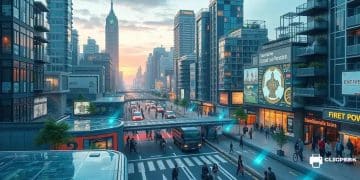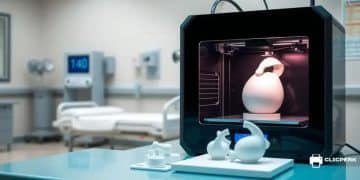Digital twins in urban planning: redefining city design

Anúncios
Digital twins in urban planning provide virtual replicas of cities, enabling real-time data analysis for better decision-making, enhanced sustainability, and improved community engagement.
Digital twins in urban planning are changing how we design our cities. Imagine having a dynamic digital replica of your urban space, helping planners tackle real-world challenges. Curious about how this technology impacts city design? Let’s dive in!
Anúncios
Understanding digital twins
Understanding digital twins is essential for grasping their role in urban planning. These innovative tools create virtual replicas of physical assets, systems, or processes. By utilizing real-time data, digital twins enable planners to visualize and analyze urban developments like never before.
With the power of digital twins, city planners can simulate different scenarios before implementing changes on the ground. This helps in making informed decisions, reducing risks, and enhancing sustainability. For example, a digital twin of a city can show how new transportation systems might impact traffic flow and air quality.
Key Features of Digital Twins
Digital twins offer several significant features that make them invaluable for urban planning:
Anúncios
- Real-time monitoring: They collect data continuously, providing up-to-date insights.
- Scenario simulation: Users can model various environments and responses.
- Predictive analysis: These systems can forecast potential challenges and outcomes.
The use of digital twins also streamlines collaboration among various stakeholders. Engineers, city officials, and community members can access the same data, ensuring everyone is on the same page. This transparency fosters better communication and supports more participatory planning processes.
Furthermore, digital twins can identify inefficiencies in city operations. For instance, they can help visualize how energy consumption varies throughout a neighborhood, guiding decisions on where to implement energy-saving measures. As cities grow, adapting and improving operational systems is crucial for addressing future challenges.
Challenges of Understanding Digital Twins
Although the concept of digital twins is promising, it comes with challenges that planners must navigate:
- Data privacy: Handling sensitive information requires strict protocols.
- Integration with existing systems: Legacy systems can complicate the implementation of digital twins.
- Technical expertise: Cities may need to invest in training for staff to effectively use this technology.
Despite these hurdles, the potential benefits of using digital twins in urban planning far outweigh the challenges. By embracing this technology, cities can tackle issues like congestion, pollution, and urban sprawl with greater effectiveness.
Applications of digital twins in urban environments
The applications of digital twins in urban environments are vast and impactful. These powerful tools can transform how cities are managed and planned. For example, digital twins can simulate urban growth, allowing planners to see how different factors, like population changes and new developments, may affect the city over time.
One prominent application is in transportation planning. By using real-time data, city officials can analyze traffic patterns, modify routes, and optimize public transport schedules. This proactive approach can significantly reduce congestion and improve the overall efficiency of urban transit systems.
Smart City Initiatives
Digital twins play a crucial role in the development of smart cities. They integrate various technologies to enhance urban living. Key aspects include:
- Energy management: Monitoring energy usage helps identify areas for improvement.
- Public safety: Real-time data can enhance emergency response times and resource allocation.
- Environmental monitoring: Tracking pollution levels and green spaces supports sustainable planning.
These applications highlight how digital twins help create safer, more efficient city environments. Additionally, they promote community engagement, as citizens can access information about urban projects and contribute their opinions.
Another area where digital twins are valuable is in asset management. Cities can manage public infrastructure, such as roads and bridges, more effectively by maintaining accurate digital records. This enhances the city’s ability to plan for repairs and allocate funds appropriately.
Urban Resilience and Sustainability
Digital twins can also aid in improving urban resilience. By modeling disasters or unexpected events, cities can prepare for various scenarios. For instance, planners can simulate flooding in a specific area and devise strategies to mitigate damage effectively. This proactive planning helps communities recover more quickly from disasters.
Moreover, sustainability initiatives benefit from the insights provided by digital twins. Cities can track their carbon footprints and assess the impact of new policies on environmental goals. This data-driven approach allows for more informed decisions that align with long-term sustainability objectives.
Benefits of using digital twins for city planners

The benefits of using digital twins for city planners are extensive and transformative. By leveraging this technology, planners can create accurate representations of their cities, allowing for better decision-making and planning. These digital models reflect real-world conditions, making it easier to identify issues before they become problems.
One significant advantage is improved collaboration among stakeholders. Digital twins allow different departments, such as public works, urban planning, and community services, to share insights and data. This sharing leads to more efficient planning and a unified approach to urban development.
Enhanced Planning and Forecasting
Using digital twins can also enhance planning and forecasting by providing predictive analytics. Planners can simulate various scenarios and see potential outcomes based on changes in infrastructure or policy. This foresight enables cities to adapt quickly to evolving needs.
- Scenario testing: Planners can alter variables to see how the city might respond.
- Resource allocation: Understanding future demands helps allocate resources more efficiently.
- Cost savings: Early identification of potential issues can reduce costly mistakes.
Moreover, digital twins contribute to sustainable development. City planners can use these models to explore green initiatives and reduce environmental impact. By simulating energy consumption and emissions, they can devise better strategies for creating greener cities.
Another notable benefit is enhanced public engagement. Digital twins can visually illustrate proposed changes to the public. This transparency fosters community involvement, as citizens can provide feedback based on clear representations of future projects. Engaging the public early in the planning process can lead to greater acceptance and support for new initiatives.
Improved Maintenance and Management
Digital twins are also valuable for ongoing maintenance and management of urban infrastructure. They enable real-time monitoring of public assets, allowing planners to address issues proactively rather than reactively. For example, sensors integrated into the digital twin model can alert city officials to maintenance needs on roads or bridges, extending their lifespan and improving safety.
Additionally, with the insights gained from digital twins, city planners can develop more resilient urban environments. By preparing for various scenarios, such as extreme weather events, cities can enhance their ability to respond to and recover from emergencies.
Challenges in implementing digital twins
Implementing digital twins brings several challenges that city planners must address. While the benefits are significant, the path to incorporating this technology is not always straightforward. One major challenge is the need for high-quality data. Digital twins rely on accurate information to function effectively. If the data is outdated or erroneous, the digital twin’s accuracy will suffer.
Another challenge is the integration with existing systems. Many cities have legacy infrastructure that may not easily connect to new technologies. This can create complications during implementation. It requires planning, resources, and often retraining staff to navigate these issues.
Cost Considerations
Costs associated with developing and maintaining digital twins can also be a barrier. Investing in the necessary hardware, software, and training can be significant. Cities need to consider their budgets and prioritize where to allocate funds effectively.
- Budget constraints: Limited finances can slow down adoption.
- Long-term investment: Digital twins may require ongoing maintenance costs.
- Return on investment: Justifying the costs with measurable benefits can be challenging.
Moreover, the complexity of setting up digital twins requires specialized skills. Cities may need to hire experts or train existing staff to effectively manage this technology. The learning curve can be steep, often preventing quick implementation.
Additionally, data privacy and security present challenges when implementing digital twins. Handling sensitive information requires implementing stringent data protection measures. Finding a balance between transparency and privacy can be difficult for city planners.
Organizational Challenges
Cultural resistance within organizations can also hinder the adoption of digital twins. Employees may be hesitant to embrace new technologies, fearing job displacement or additional complexities. Educating staff about the benefits of digital twins is crucial to overcoming this resistance.
Furthermore, collaboration among different departments can pose difficulties. Each department may have its priorities, leading to conflicts in how digital twins should be used. Ensuring all stakeholders are on the same page is essential for successful implementation.
The future of urban planning with digital twins
The future of urban planning with digital twins looks promising and innovative. As technology advances, cities are beginning to use digital twins not just for visualization, but also for comprehensive management and real-time decision-making. These virtual models enable city planners to analyze trends and anticipate challenges more effectively.
In the coming years, we can expect to see greater integration of smart technologies with digital twins. More sensors and IoT devices will be deployed throughout urban environments, providing vast amounts of real-time data. This wealth of information will enhance the accuracy and utility of digital twins, resulting in more informed planning decisions.
Improved Sustainability Efforts
Digital twins will play a crucial role in driving sustainability initiatives within cities. By simulating the impact of new policies and urban developments, planners can assess environmental implications before implementation. This will allow cities to create greener spaces, optimize energy usage, and reduce their carbon footprint.
- Energy efficiency: Digital twins can analyze energy consumption patterns to identify where savings can be made.
- Green infrastructure: Planners can visualize the benefits of parks and green roofs.
- Pollution reduction: They can model how changes in traffic patterns affect air quality.
As urban populations grow, the demand for effective public services increases. Here, digital twins can help design better systems for transportation, waste management, and emergency services. By predicting future demands, cities can allocate resources more effectively and enhance the quality of life for residents.
Enhanced Community Engagement
Another aspect of the future is improved community engagement through digital twins. As city planners develop these models, they can share them with residents to foster transparency. Citizens will be able to interact with digital twins, providing feedback and participating in planning processes. This collaborative approach will result in urban environments that better reflect the needs and desires of the community.
Urban resilience will also benefit from digital twins. As cities face challenges like extreme weather, digital twins can simulate impacts and aid in developing robust responses. Cities can plan for disasters and reduce recovery times, ensuring safer living conditions.
As we look ahead, the potential of digital twins in urban planning is vast. The technology not only provides a tool for analysis and visualization but creates a framework for embracing innovation, community involvement, and sustainability in our cities.
FAQ – Frequently Asked Questions about Digital Twins in Urban Planning
What are digital twins and how are they used in urban planning?
Digital twins are virtual replicas of physical environments that use real-time data to simulate and analyze urban systems. They help planners make informed decisions.
How can digital twins improve sustainability in cities?
Digital twins allow planners to assess the environmental impact of new projects, optimize energy usage, and support green initiatives, leading to greener urban environments.
What challenges do cities face when implementing digital twins?
Cities may encounter issues like data quality, integration with existing systems, cost considerations, and the need for specialized skills during implementation.
How can digital twins enhance community engagement?
Digital twins can be shared with residents, allowing them to visualize urban changes and provide feedback, fostering a sense of involvement in planning processes.





